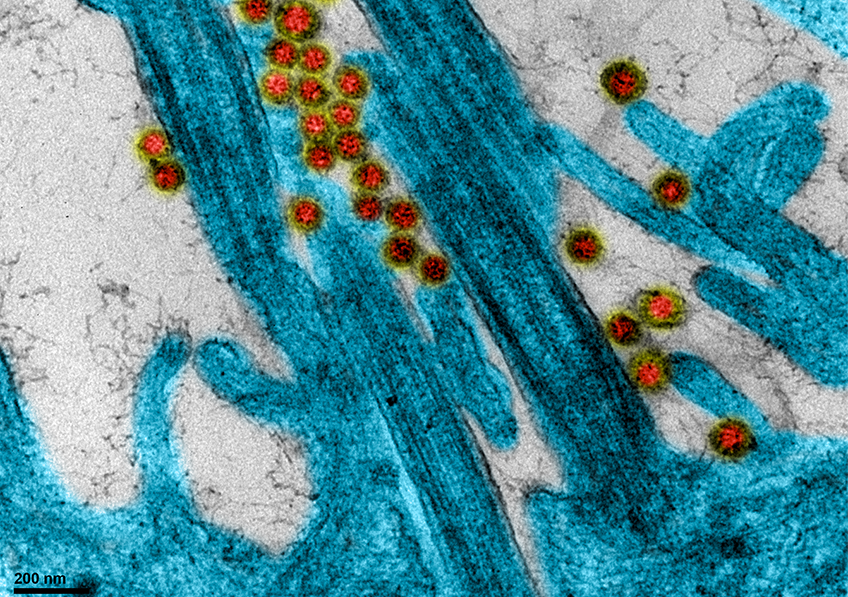Researcher Contact
Jade Ghosn
U1137 IAME (Inserm/université de Paris)
Hôpital Bichat Claude-Bernard AP-HP
Cédric Laouenan
U1137 IAME (Inserm/université de Paris)
Hôpital Bichat Claude-Bernard AP-HP

SARS-CoV-2 coronavirus attached to human respiratory epithelial cell cilia. © Manuel Rosa- Calatrava, Inserm; Olivier Terrier, CNRS; Andrés Pizzorno, Signia Therapeutics; Elisabeth Errazuriz-Cerda UCBL1 CIQLE. VirPath (International Research Center for Infectious Diseases U1111 Inserm – JRU 5308 CNRS – ENS Lyon – UCBL1). Colorized by Noa Rosa C.
How long can COVID-19 symptoms persist after hospitalization for SARS-CoV-2 infection? Scientists continue to have many questions about this emerging virus and the long-term impacts of the disease it causes. The teams studying the problem of so-called “long COVID” include the investigators of the French COVID cohort, sponsored by Inserm. In a new study published in the journal CMI, these researchers from Inserm, the Paris hospitals group AP-HP and Université de Paris show that a significant proportion of patients who were hospitalized and followed up as part of French COVID continue to have symptoms three and six months after infection.
Is it possible to have COVID-19 symptoms several months after being infected with SARS-CoV-2? The question of “long COVID” continues to interest the scientific and medical community and is at the center of a number of research projects, notably those conducted by the French COVID investigators.
Launched at the end of January 2020, French COVID is a French cohort study sponsored by Inserm. It is based on the follow-up of a large group of patients having developed a clinical form of the disease that required hospitalization, either in a medical department or in intensive care. As at March 17, 2021, a total of 4,310 patients had been enrolled in this cohort, the largest French cohort to date of patients hospitalized with SARS-CoV-2 infection.
For each participant, clinical, virological, immunological, genetic, serological and transcriptomic data are collected in order to better characterize the disease. The objective is to build up knowledge on COVID-19, especially its most severe forms, in order to improve management in cases where hospitalization is required. The aim is also to better understand the short and long-term outcomes of patients by looking at the potential persistence of symptoms in the months following diagnosis.
Impact of long COVID
In their new study, the team describes the frequency and nature of symptoms persisting in 1,137 patients from the French COVID cohort, assessed at follow-up visits three and six months after they were hospitalized for COVID-19.
A correlation between the initial severity of the disease and the persistence of symptoms over the long term also appears to be emerging. Indeed, the persistence of three or more symptoms six months after infection is more common in those whose COVID-19 disease required a stay in ICU compared with those hospitalized in a medical department, and in the most symptomatic patients on the day of hospital admission. The researchers also observe differences according to sex: while men are at greater risk of severe forms, women appear to be at greater risk of persistent symptoms over time.
In order to better understand the consequences of the virus on the body and the long-term impact of the disease, and above all to provide better patient care, continuing this follow-up beyond six months on an even larger population could be of great interest.
“The mechanisms that cause symptoms to persist after the body has rid itself of the virus remain unclear. We will continue to follow up the patients included in French COVID up to 18 months after infection, by also proposing tests to evaluate the neurocognitive functions,” emphasizes the cohort’s coordinator, Jade Ghosn, who is an associate professor-hospital practitioner at Université de Paris and a professor in the Department of Infectious and Tropical Diseases at Bichat Claude-Bernard Hospital AP-HP.
Jade Ghosn
U1137 IAME (Inserm/université de Paris)
Hôpital Bichat Claude-Bernard AP-HP
Cédric Laouenan
U1137 IAME (Inserm/université de Paris)
Hôpital Bichat Claude-Bernard AP-HP
Persistent COVID-19 symptoms are highly prevalent six months after hospitalisation: results from a large prospective cohort
Jade GHOSN, MD, PhD1,2, Lionel PIROTH, MD, PhD3, Olivier EPAULARD, MD, PhD4, Paul LE TURNIER, MD5, France MENTRE, MD, PhD1,6,7, Delphine BACHELET, PhD6,7 and Cédric LAOUENAN, MD, PhD1,6,7, for the French COVID cohort study and investigators groups
1 Université de Paris, INSERM, IAME UMR 1137, Paris, France
2 AP-HP, Hôpital Bichat, Infectious and Tropical Diseases Department, Paris, France
3 Infectious Diseases Department, University Hospital and INSERM CIC 1432, Dijon, France
4 Infectious Diseases Unit, Centre Hospitalier Universitaire Grenoble Alpes, Grenoble, France
5 Department of Infectious Diseases, Hotel-Dieu Hospital – INSERM CIC 1413, Nantes University Hospital, Nantes, France
6 INSERM, Centre d’Investigation clinique-Epidémiologie Clinique 1425, Hôpital Bichat, Paris, France
7 AP-HP, Hôpital Bichat, Departement of Epidemiology Biostatistics and Clinical Research, Paris, France
CMI, mai 2021